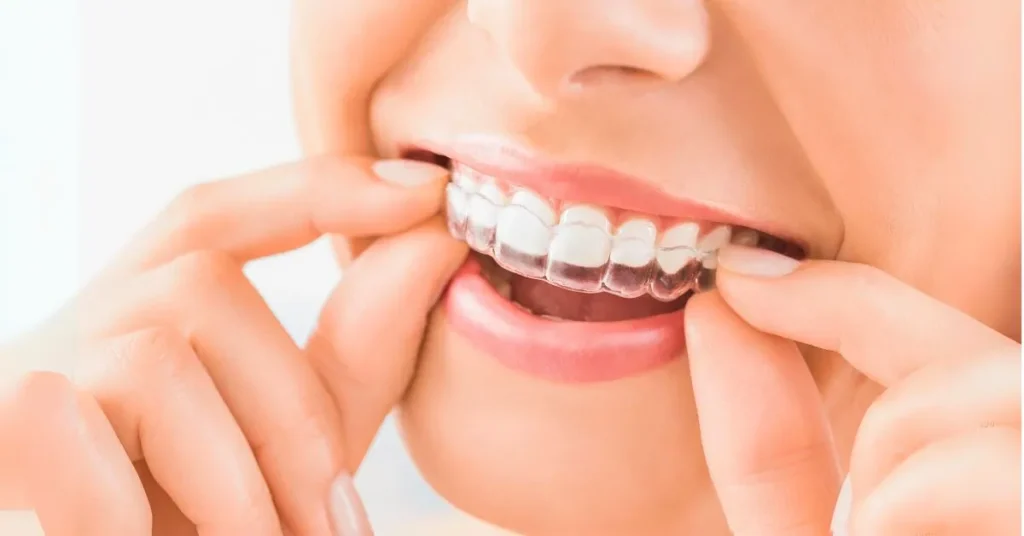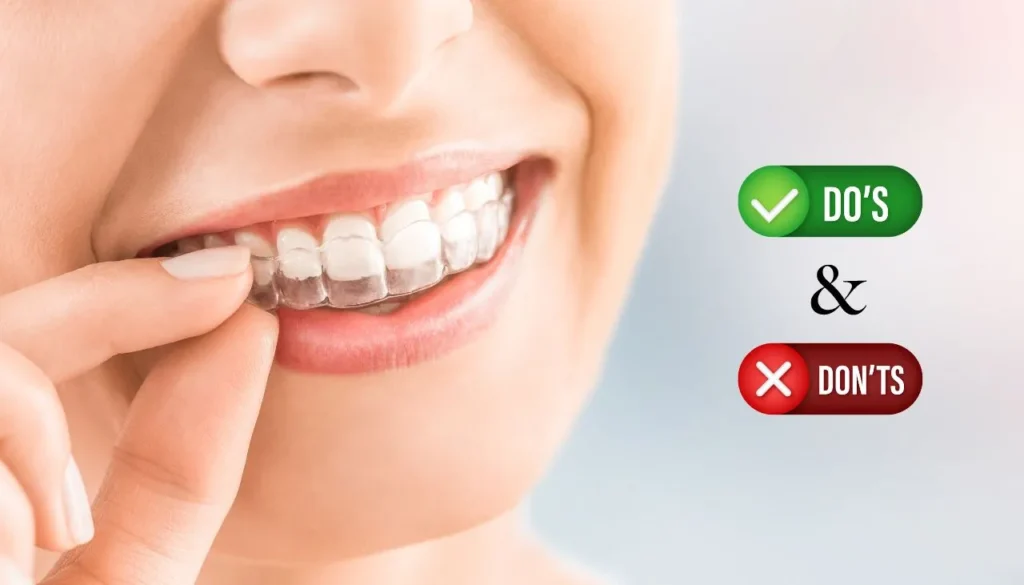For minor to major dental flaws, braces are a popular solution around the world. Braces are orthodontic devices that are crafted to correct issues like crooked, gapped, or other issues involving teeth, thus correcting the smile lines.
If you are exploring orthodontic solutions for your dental problems, you have landed in the right place. This blog may help you with finding the right braces for you. Let’s begin.
What are Clear Aligners?
Clear aligners are plastic orthodontic devices made for hassle-free and comfortable everyday use. These braces are invisible once put on. Unlike metal braces, aligners are painless, comfortable, and portable. In this process, the patients are guided through a digital scan. Then they will be provided with a customized series of clear plastic aligners that are invisible and, at the same time, are removable for eating, drinking and other special occasions.
What are Metal Braces?
Traditional braces or metal braces consisted of arch wires and metal brackets designed to create gentle pressure on the wearer’s teeth to reshape or correct their dental problems in a prescribed period. Braces are available in both standard metal brackets as well as clear or tooth-coloured ceramic or plastic brackets and wire for minimum visibility.
How do Clear Aligners Work?
Clear aligners are the newest and the most advanced elements of the teeth straightening process to date that are customized as per the client’s requirements. Similar to traditional braces, aligners work by exerting gentle pressure to gradually straighten teeth over some time. Each aligner directs tooth movement, and teeth will move approximately 0.2mm to 0.3mm with each new set.
How do Metal Braces Work?
The metal braces are either cement or bonded directly to the teeth. A flexible wire fits through slots in the brackets to connect and hold the braces together. The braces apply gentle pressure on the teeth to move and realign. A person may also need to wear elastic bands to provide individual tooth realignment and movement during the treatment.
Comparison Table: Clear Aligners vs. Metal Braces
| Factors | Clear Aligners | Metal Braces |
| Material | Elastic thermoplastic | Stainless Steel |
| Appearance | Transparent | Steel Colour |
| Removability | Yes | No |
| Usage & Cleaning | Easy | Difficult |
| Free to eat | Yes | No |
| Cost | 45,000-2,00,000 | 25,000-40,000 |
| Treatment Period | 12-18 months | 2-3 years |
| Suitability | Suitable for mild to moderate cases | Work in all cases |
Comparison Between Clear Aligners and Metal Braces
Cost Comparison
Clear Aligners: Clear aligners are a bit more expensive than metal braces. Depending on the various orthodontic cases, the treatment cost ranges from INR 45k to INR 2 lakh.
Metal Braces: Metal braces are more cost-effective than alternative orthodontic treatments such as clear aligners or lingual braces. The price range varies between INR 25k to 40k for a treatment involving metal braces.
Treatment Duration:
Clear Aligners: The treatment period also varies from concern to concern. However, a minimum of 6 to 18 months is required to obtain desired results.
Metal Braces: Metal braces require a longer treatment duration than newer orthodontic options like clear aligners. Usually, it takes one to two years or more to correct the patient’s dental flaws.
Effectiveness
Clear Aligners: Clear aligners can treat less crooked teeth, gapped teeth, and misaligned bites but are unsuitable for conditions like extremely crooked teeth, cross-bites, and malocclusions.
Metal Braces: Metal braces are highly effective at correcting a wide range of dental issues, including severe misalignments and bite problems. Metal braces are fixed appliances that allow for better control and more precise teeth movement, especially in complex cases than aligners. Experts say metal braces are more helpful in conditions like teeth rotation, retention after removal and certain malocclusions.
Comfort and Convenience:
Clear Aligners: Aligners are superbly comfortable compared to braces as they are made of thin plastic, so no wires or metals are involved.
Metal Braces: Metal braces can cause discomfort, irritation, and even sores in the mouth, especially during the initial adjustment period and after tightening appointments.
Appearance:
Clear Aligners: The aesthetic appeal of wearing clear aligners is their primary advantage. It fits and works invisibly, making the wearer more confident and comfortable while talking or smiling.
Metal Braces: One of the most significant drawbacks of metal braces is their conspicuous appearance, which may affect the wearer’s confidence, particularly for adults.
Removability:
Clear Aligners: Clear aligners are easily removable dental clips that are advised to be removed while eating and brushing. The wearer can remove and fix it again in minutes without any fuss.
Metal Braces: Metal braces are fixed and attached by the orthodontist and are maintained by professionals only.
Diet: Foods to Eat and Avoid
Clear Aligners: No diet restrictions are involved as aligner trays are removed during eating.
Metal Braces: Wearers of metal braces must adhere to certain dietary restrictions to prevent damage to the braces, such as avoiding sticky or hard foods.
Maintenance:
Clear Aligners: Since the aligners are easily removable, brushing teeth and cleaning the aligners tray are very convenient.
Metal Braces: Maintaining good oral hygiene can be more challenging with metal braces due to the presence of brackets and wires, which can trap food particles and plaque.
Pros and Cons
Clear aligners:
| Pros | Cons |
| 1. Easy to use and comfortable 2. Virtually invisible, enhancing aesthetics 3. No diet restrictions 4. Lightweight 5. No metal 6. Removable | 1. Not recommended for complex cases 2. Generally more expensive 3. May have a longer treatment duration (6 to 18 months) |
Metal braces:
| Pros | Cons |
| 1. Effective for critical orthodontic issues 2. Generally more affordable 3. Shorter treatment period (1 to 2 years) 4. Offer long-term effectiveness in treatment | 1. Uncomfortable due to metal brackets and wires 2. Cannot be removed, leading to potential oral hygiene challenges 3. Visible and may affect aesthetics 4. May have long-term effects |
Final Verdict
Ultimately, the decision to use either traditional metal braces or clear aligners should be made in consultation with an orthodontist. Considering individual dental needs, lifestyle preferences, and treatment goals plus your research altogether, will guide you towards a better choice for your orthodontic solutions. Providing many more conveniences than their metal counterparts, clear aligners are the new favourite of young adults.
If you are looking for aesthetic orthodontics with long-term benefits, then clear aligners are the right fit for you. Contact us today for a better overview of advanced and futuristic orthodontic solutions near you.
FAQs
Switching from metal braces to clear aligners is possible, as clear braces are just as effective as traditional metal braces.
Both the braces are great for crooked teeth, overbite, gaps, crowding, etc. However, clear aligners may not be helpful in some cases where the teeth need to be raised to match other teeth or in the case of rotated teeth.
Clear aligners are less painful than metal braces. Some people experience minor discomfort during the initial days of using aligners.

